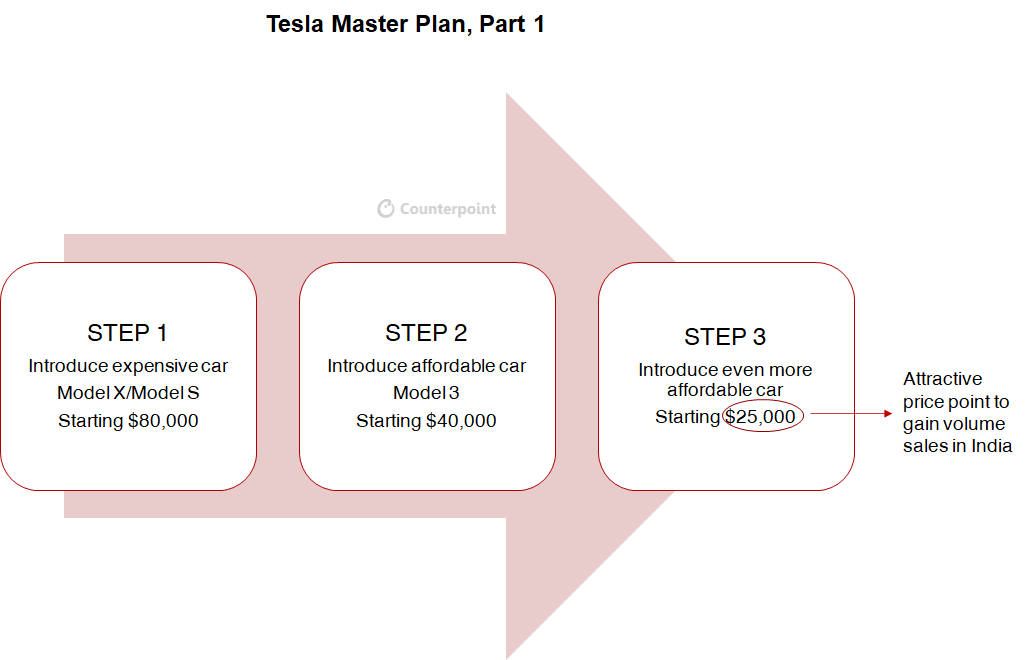Tesla – A Game Changer for India’s EV Industry?
Stagnating electric vehicle (电动汽车) sales in the US have ledTesla探索海外markets in Europe andChina. But the increasing competition in the电动汽车segment and the company’s own ambitions make it imperative to look beyond these markets. It is with this in mind that Tesla recently announced its entry intoIndia. No doubt it is an excellent move by the automaker which delivered close to 500,000 vehicles globally in 2020 and plans to produce 20 million vehicles per year by 2030.
However, the way forward for Tesla in a developing country likeIndiarequires a closer scrutiny of the market and the challenges it poses. To begin with, Tesla will have to launch an affordable EV in the country to achieve volumes and long-term success. A local manufacturing base will help here. Inadequate charging infrastructure is both a challenge and an opportunity. The automaker can set up a network of charging stations in key cities to gain an early-mover advantage.
At the same time,Tesla’sIndia entry has the potential to speed up ecosystem development in the country, encouraging other automakers and suppliers to firm up their EV plans.
Pricing a key factor
A typicalIndian carbuyer is highly cost-sensitive. Budget cars costing $8,000-$10,000 account for a vast majority of car sales in the country. Much of Tesla’s success in India will depend on the price at which it launches its EVs.
- Annual luxury car sales are just around 35,000 units in India. Therefore, Model 3 will not find many buyers in the country. However, Tesla has a long-term plan to launch an EV priced at $25,000. Given the battery design, material and production innovations the company is undertaking, Tesla should be able to launch the $25,000 EV in the next three years.

- Considering Tesla sets up local manufacturing in the country, this car can be offered at a price at least 20% lower. This is an attractive price point, accounting for some 300,000 units of annual sales and having high growth potential.
Why India?
Indiais among the most polluted countries in the world. But the eagerness to curb pollution levels in the country is rising among all stakeholders. The low penetration of cars in the country, coupled with rising income levels, also makes India an attractive market for automakers. Below are the key factors that will aid Tesla’s success in the country:
- Stringent emission norms make way for EVs:In 2020,Indialeapfrogged from BS-IV to BS-VI (equivalent to Euro 6) emission norms. Corporate Average Fuel Efficiency norms require automakers to improve their fuel efficiency by 10% by 2021 and by 30% or more from 2022, when compared to that in 2017. While still a long way to go in terms of EV incentives, policies like Faster Adoption and Manufacturing of Hybrid and Electric Vehicles have generated industry interest in EVs.
- Huge potential:Indiais the fourth largest automotive market with more than 4 million vehicles sold annually. Despite this, car penetration in the country stands at 22 per 1,000 individuals compared to 980 and 850 in the US and the UK respectively, presenting a huge potential for long-term growth.
- 改变客户的偏好:Income levels continue to rise in India. Car buyers are upgrading from budget to mid-premium cars while preferring latest digital technologies and becoming increasingly concerned over growing pollution levels.
Recommendations
Tesla’s move to enter India is certainly not aimed at selling its Model 3 in large volumes but to get an early-mover advantage when EVs prices reach cost parity with conventional vehicles. Below are some areas that Tesla should focus on during its initial years in the country:
- Set up a network of fast chargers:Tesla should set up a network of fast-charging stations in key cities, where buyers can afford a $20,000 car, to tackle the range anxiety issue that potential customers may face while deciding to buy a Tesla.
- 市场研究:As Tesla is a new player, studying the local market, gaps left by established players (like Daimler and BMW) and pain points of its target customers is of paramount importance.
- Brand building:The automaker should invest in building a brand which stands for luxury, performance and innovation. Tesla should build on its already positive word of mouth in the country.
- Local manufacturing:Tesla should set up a local manufacturing unit for assembly and battery to reduce costs and use it as an export hub for Southeast Asian and African countries. Pro-investment polices like Make in India and 100% FDI route for the automotive sector have made India an attractive country to set up local manufacturing.
- Global R&D center:Tesla should set up an R&D center in the country, employing young, tech-savvy engineers at a lower cost. Tesla can take advantage of the country’s prowess in software development to improve its embedded software, OTA and cloud ecosystems.


